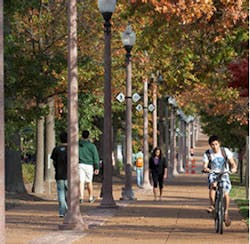Webcams help researchers analyze the use of open space
A new study by researchers at Washington University in St. Louis (St. Louis, MO, USA) is one of the first to use images captured from cameras to help measure how built environments such as parks, greenways, trails and other man-made public areas are used by the public.
"By helping communities measure how effective cycling infrastructure, greenways, trails, parks and open space can be, we can both raise awareness and help communities build better environments," says Dr. J. Aaron Hipp, an assistant professor of public health at Washington University's Brown School.
The research was conducted using publicly available outdoor webcams and crowd-sourcing. The team used webcam imagery and a crowd-sourcing approach to count people, bikes and cars, in rainy, foggy or crowded conditions where automatic methods fail and research assistants struggle due to weather and numbers
A web tool called the Archive of Many Outdoor Scenes (AMOS) developed by Professor Robert Pless from the Washington University school of engineering and applied science gave the researchers thousands of images to study.
AMOS uses publicly available outdoor webcams and a custom web crawler to capture webcam images with a time stamp -- one image per camera every half hour.
From there, the Amazon Mechanical Turk (MTurk) website was used to crowd-source the image annotation and collect data. MTurk workers were paid one cent to mark each pedestrian, cyclist and vehicle in a picture. Each image was counted fıve times and the whole process was completed in less than eight hours.
One study focused on an intersection in Washington, DC, at Pennsylvania Avenue NW and 9th Street NW in June of 2009 and June of 2010, during which time a bike lane had been installed. Through the analysis of the images from the cameras there, the researchers found cycling activity in the area increased four-fold once the lane was built.
Related articles on crowd-sourcing from Vision Systems Design that you might also be interested in.
1. Image annotation combines machine vision and crowd-sourcing
A PhD student at the University of California, San Diego (USCD; San Diego, CA, USA) has received a Small Business Innovation Research award from the National Science Foundation (NSF) to investigate the viability of an image annotation system that uses a combination of machine vision and crowd-sourcing.
2. Kinect comes home
Three Swedish researchers from the Centre for Autonomous Systems (CAS) at the Kungliga Tekniska Hogskolan (KTH) in Stockholm, Sweden are asking people to get involved in a crowd sourcing project to build a library of 3-D models of objects captured using their Microsoft Kinect cameras.
3. Computer software recognizes sketches
Researchers at Brown University (Providence, Rhode Island, USA) and the Technical University of Berlin (Berlin, Germany) have developed computer software that can identify simple abstract sketches of objects as they are being drawn.
-- Dave Wilson, Senior Editor, Vision Systems Design
